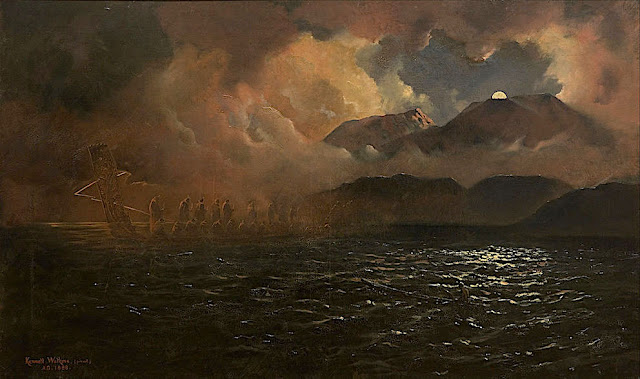
CLAUDE MONET (1840-1926)
Kolsås or Kolsass mountain (342 m - 1,122 ft)
Norway
In "Le village de Sandviken, près du Mount Kolsaas" Norvège, 1895, Huile sur toile 73,4 x92, 5 cm - Art Institute Chicago
Monet and Mount Kolsass
A text in french from the book Claude Monet, une vie dans le paysage by Marianne Alphant - Editions Hazan, 1993. (You may use the Google translation tool in this blog to tranlaste into your own langage)
« Au cours l'hiver 1895 le peintre français fit un séjour en Norvège. et peignit a plusieurs reprises à différentes heures du jour et dans différentes conditions climatiques une montagne, le mont Kolsaas. Mais sitôt réalisées leur auteur n'en fut guère satisfait et elles furent vite éclipsées par l'exposition des Cathédrales. Des vingt-sept ou vingt-huit qui furent recensées, le musée Rodin n'en propose qu'une douzaine, issues de collections publiques (Orsay, Marmottan) aussi bien que privées (Japon, Etats-Unis) et déjà présentées à Stavanger, en Norvège.
Monet effectua ce long voyage vers le Nord sur l'invitation de son beau-fils Jacques Hoschedé, pour saisir quelques effets de neige qu'il escomptait bien capter facilement là-bas. En quoi il se trompait généreusement, erreur à l'origine d'un de ses plus intéressants ratages.
Les quatre «portraits» du mont Kolsaas sont assez intrigants en ce que l’on y perçoit tout l'art du peintre pour «rendre» l'impalpable bien que cela l'entraînent vers des contrées inexplorées. « Le motif se met à flotter dans une atmosphère qui ne le porte plus, ne le soutient plus, l'abandonnant au gré d'une humeur vagabonde, à la manière d'un nuage libre de dériver au gré des vents. L'impression d'échec provient alors d'une incapacité à arrimer la figure, à saisir l'objet à bras le corps, à se tenir d'aplomb face à ce qui le surplombe. Mais la valeur inestimable de cet apparent échec excède largement cet effet de brouillon. (…)
Les peintures ne doivent pas leur sentiment d'incomplétude à une quelconque précipitation mais bien plutôt au désir de se fondre dans un immense éloge à la blancheur. (…)
Le mont Kolsaas ressemble de la sorte au dernier souffle ou à l'éternuement d'un linceul qui, l'instant suivant, s'affaissera dans l'indéterminé d'une forme sans contour. Autrement dit, l'informe. Ces quelques peintures représentent sans doute l'une des rares tentatives de distinguer la neige de la blancheur, de séparer les deux corps comme on le ferait dans une expérience chimique de dissociation. Car la neige n'est pas blanche, pas plus que le blanc n'est la couleur de la neige. L'un et l'autre entrent doucement en conflit pour que, dans l'intervalle, à la faveur d'une anecdote petit pont ou rivière , se glisse l'élément qui permettra de rassurer la vision. Entre la neige et la blancheur, il y a un mariage fatal qu'il faut à tout prix éviter faute de s'y endormir. Entre le ciel et le bleu, c'est pareil mais c'est une autre histoire. Les deux histoires se rejouent chaque fois qu'un peintre essaie de fixer leur frontière, leur bord extrême. Comment cette peinture pourrait-elle alors s'achever ?."
The mountain
Kolsås or Kolsass Mountain (342 m - 1,122 ft) is a wooded mountain ridge in the municipality of Bærum, Norway. Geologically, Kolsås belongs to the Oslo Graben area. Its two peaks (one at 387m the other at 342m) consist of hard rhomb porphyric lava covering softer rocks, forming steep cliffs to the east, south and west. An old farm beneath the mountain has the name Kolsberg. The first element in this name is the genitive case of the old male name Kolr, and the last element is "berg" (mountain). The parish and municipality of Bærum (Old Norse Bergheimr) is probably named after this prominent mountain. The last element in the name of the mountain was later changed to ås (mountain ridge) to distinguish it from the name of the farm.
The French painter Claude Monet painted Mont Kolsaas in 1895 in a series of 4 paintings one is permanently shown at the Musée d’Orsay , an other in Musée Marmottan. in Paris The 2 others shows on this blog are held in private collections in USA and Japan.
The painter
The painter Oscar-Claude Monet better known as Claude Monet was a founder of French Impressionist painting, and the most consistent and prolific practitioner of the movement's philosophy of expressing one's perceptions before nature, especially as applied to plein-air landscape painting. The term "Impressionism" is derived from the title of his painting « Impression, soleil levant » (Impression, Sunrise), which was exhibited in 1874 in the first of the independent exhibitions mounted by Monet and his associates as an alternative to the Salon de Paris.
Monet's ambition of documenting the French countryside led him to adopt a method of painting the same scene many times in order to capture the changing of light and the passing of the seasons exactly like the japanese artist Hokusai (1760-1849) did with his 36 views of Mount Fuji.
Monet repeated this kinf of "exercise de stylee with his series on Les Petites Dalles.
___________________________________________
2021 - Wandering Vertexes...
by Francis Rousseau

















